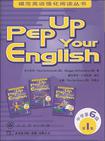PEP UP Your English中学第6级第1集
2002-11
人民教育出版社
Paul Simmonds,Maggie Aldhamlan
357
无
阅读是理解和吸收语言文化信息的最重要的手段。对学生来说,阅读又是语言文化信息的最便捷的输人源。没有足够的可理解性语言的输入,就不可能有高质量的语言输出。古人云:“读书破万卷,下笔若有神”,讲的就是这个道理。 因此,“国家英语课程标准”很重视学生的阅读训练,对阅读技能的九级要求做了详细的目标描述,并对第三至八级的课外阅读量定出了明确的要求(由4万词累积到36万词)。而且,历届的中考和高考都特别重视语篇的理解。显然,要达到课程标准的要求,要获得良好的考试成绩,学生单靠教科书是远远不够的,必须开展大量的阅读。本套丛书就是为了实施课程标准,为了满足我国中学生的英语阅读需要专门设计编制的。与许多引进版的读物不同的是,这套读物是由中外专家合作,完全根据课程标准规定的教育目标、教学要求、教学内容设计编写的。书中文章不仅语言地道、规范,而且具有较强的跨文化交际的意识,既介绍了世界各国的文化,也注意弘扬中华民族的优秀文化。本套读物具有以下六个特色:针对性强适于初中、高中或同等水平的学生阅读。本套读物的第1级适于小学起始学习英语的初中一年级学生阅读,程度大体相当于英语课程标准的三级。由此类推,其第6级则适于高中三年级的学生阅读,程度可达到八级以上。每一级(Level)又有一、二集(wave)等,由易到难,具有弹性。第6级读物将有适于达到课程标准九级水平的学生阅读的材料。书中的练习、注释等也是针对我国学生的认知特点编写的。
紧贴国家最新英语课程标准强化学生分级阅读的要求;专为中国学生量身订做,跟踪国家考试取向;组织海外和国内知名专家担任主编和作者,合作编写;英语地道标准、真实自然;题材新颖广泛,设计严谨,提高自我评价和应试能力。本丛书分为1-6级,对应课程标准中的3-8级要求,相当于初一至高三水平。每一集均包含学生用书、辅导用书。学习用书专供学生课堂上在教师指导下使用;辅导用书提供答案及译文,供教师和课外练习的学生使用。
Paul Simmonds(英国),资深英语教师,有三十年教授英语和培训英语师资的经验.并在多个国家从事过英语教育顾问工作:曾为牛津大学出版社和朗文出版公司编写英语教科书:目前在英国伯明翰大学任教。 Maggie AIdhamIand(澳大利亚),英语教科书专业作者和编辑,早年曾在新西兰任教,后于1984年受雇于澳大利亚联邦政府,专职为移民学生编写英语课本:后来移居英国.曾在剑桥大学出版社,Prentice Hall.CasselI ELT等出版公司担任教科书编辑:目前于悉尼居住,为悉尼和墨尔本的教育出版机构编写教材。
《Pep Up Your English:中学第6级(第1集) 第1册》《Pep Up Your English:中学第6级(第1集) 第2册》《Pep Up Your English:中学第6级(第1集) 第3册》《Pep Up Your English:中学第6级(第1集) 第1-3册 辅导用书》目录:前言Introduction第1集 第1册 马拉松赛跑第1单元 一个足球天才第2单元 巧克力第3单元 横渡大西洋第4单元 马拉松赛跑第5单元 智力第6单元 比萨斜塔第7单元 J·K·罗琳和《哈利·波特》第8单元 “挑战者”号航天飞机的STS一51一L飞行.第9单元 一种由来已久的疾病第10单元 自由之路第11单元猎豹第12单元喀拉喀托火山第1集 第2册 发明和设计第1单元 有发条装置的收音机第2单元 电视第3单元 火药第4单元 千禧大桥第5单元 风力第6单元 水力第7单元 指南针第8单元 多产发明家第9单元 自行车第10单元 印刷术第11单元 布莱叶盲文的完善第12单元 丝绸和丝绸之路第1集 第3册 比较第1单元 不同的学习方式第2单元 城里和乡下的对比第3单元 不同的视角第4单元 新生活——第一部分第5单元 各种各样的动物第6单元 猫科第7单元 照料动物第8单元 新生活——第二部分第9单元 谁说英语?第10单元 行星——大的、小的、远的和近的第11单元 世界是怎样创造出来的?第12单元 新生活——第三部分
Before you start(1-3)Where do you think the compass was invented,and when?Why was having a compassso important and how did it change the world?Talk to fl friend and share what you knowabout compasses,then read the first passage.Reading(1)The compass 11)In the very early days of sea transport,few sailors ventured out of sight ofIand。There were two main reasons for this.First,many of them were afraidthat they might fall off the edge of the world.Many people believed thatthe world was flat,rather Iike a plate,and that if a shiP went too far it wouldfaII off the edge and wouId be lost for ever.The second reason was thatalthough they couId normaIlY see the Sun,the stars or the Moon they oftenhad little idea of where they were going if the sky was very cloudy and ifthey were out of sight of land.Two thousand five hundred years ago in China,people had already masteredmethods of smelting iron and making iron tools。Their contact with iron oreand iron helped them to discover the magnetic properties of the metaI.There is a story(which may of course not be completely true)that a gate ofthe Qin dynasty palace was made of a piece of stone that contained a largeamount of iron ore.If soldiers secretly carrying weapons or armour tried toenter the gate,their weapons or their armour wouId become stuck to thegate and they wouId be unable to enter.Magnetic stones were often described in thepast as“south pointers”and traveIlers on landwouId sometimes use them tO find their way.Two thousand years ago,du ring the WarringStates Period.travellers used a spoon-shapedpointer where the handIe always pointed tothe south.The spoon-shaped stone would beplaced on a plate with a very smooth surfaceso that the base 0f the spoon couId rotatesmoothIy a13d come to rest pointing south..

无
PEP UP Your English中学第6级第1集 PDF格式下载